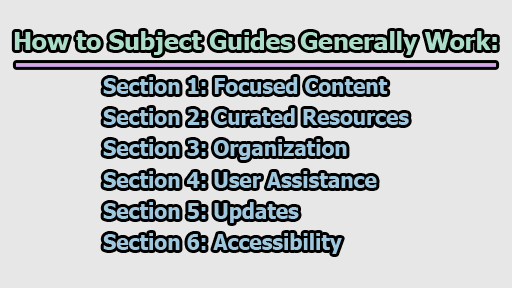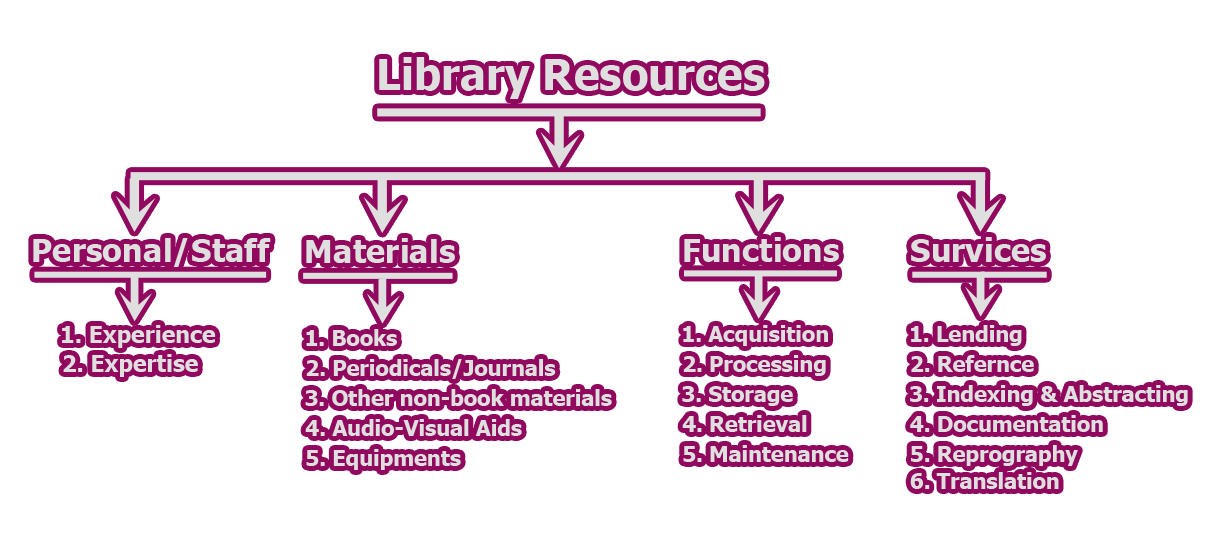How to Subject Guides Generally Work:
Subject guides, also known as research guides or pathfinders, are curated compilations of resources that help users explore and navigate information related to a specific subject or topic. They are typically created by librarians or subject specialists to assist library patrons in finding relevant materials for their research or learning needs. In this article, we will explore how to subject guides generally work.
Section 1: Focused Content:
Subject guides are meticulously crafted to concentrate on a specific subject, topic, or academic discipline. The goal is to provide users with a centralized and organized collection of resources tailored to their research needs within a particular area of interest. Here’s a breakdown of what makes the content of subject guides focused:
1.1 Narrow Scope: Each subject guide is designed with a narrow scope, focusing on a well-defined subject or academic discipline. This ensures that the resources included are directly relevant to the topic at hand, preventing information overload and streamlining the research process for users.
1.2 Targeted Audience: Subject guides are created with a specific audience in mind, such as students, researchers, or professionals within a particular field. This audience-centric approach allows librarians to tailor the guide to the needs and proficiency levels of those seeking information on the subject.
1.3 Thematic Organization: The content within a subject guide is thematically organized to present a coherent and structured overview of the chosen subject. This organization makes it easier for users to navigate the guide and locate relevant resources based on their specific research requirements.
1.4 Inclusion Criteria: Librarians carefully select resources for inclusion in subject guides based on predetermined criteria. These criteria may include the authority of the source, relevance to the subject, and the comprehensiveness of the information. By adhering to strict inclusion criteria, librarians ensure that the resources recommended in the guide meet high standards of quality and reliability.
1.5 Alignment with Curriculum: For academic subject guides, there is often a close alignment with the curriculum of educational institutions. Librarians collaborate with educators to understand the specific topics covered in courses, ensuring that the guide supports the learning objectives and research goals of students.
Section 2: Curated Resources:
Once the subject guide is designed with a focused content structure, the next crucial aspect is the curation of resources. Librarians or subject specialists play a key role in selecting and compiling a diverse range of relevant materials to support users in their research. Here’s an explanation of how resources are curated for subject guides:
2.1 Diverse Resource Types: Librarians include a variety of resource types to cater to different learning preferences and research needs. This may encompass books, academic articles, multimedia materials, databases, websites, and more. The inclusion of diverse formats ensures that users have access to a comprehensive set of information sources.
2.2 Quality Control: The selection process involves a thorough evaluation of the quality and reliability of each resource. Librarians consider factors such as the author’s credibility, the publication source, and the accuracy of the information. This quality control mechanism aims to present users with trustworthy and authoritative content.
2.3 Relevance to the Subject: Every resource included in the subject guide is directly relevant to the chosen subject or topic. Librarians carefully assess the content to ensure it aligns with the scope and objectives of the guide, enhancing its utility for users conducting research within that specific domain.
2.4 Currency: Keeping information current is a priority in resource curation. Librarians regularly update the subject guide to reflect the latest developments in the field. This may involve replacing outdated resources with more recent publications or incorporating emerging trends and research findings.
2.5 Accessibility: Librarians consider the accessibility of resources to ensure that users can easily obtain or access the recommended materials. This may involve providing direct links to online articles or specifying the location of physical resources within the library.
2.6 User-Friendly Annotations: To assist users in understanding the relevance of each resource, librarians often provide brief annotations or descriptions. These annotations highlight key points, topics covered, and the potential usefulness of each resource, aiding users in making informed decisions about which materials to explore further.
Section 3: Organization:
The organization of a subject guide is a crucial aspect that contributes to its usability and effectiveness. Librarians carefully structure the content in a thematic and user-friendly manner to facilitate easy navigation and access to relevant information. Here’s an exploration of how subject guides are organized:
3.1 Thematic Segmentation: The content within a subject guide is segmented into thematic sections or categories. Each section focuses on a specific aspect or subtopic related to the broader subject. This thematic segmentation allows users to quickly identify and navigate to the areas of the guide that align with their research interests.
3.2 Logical Flow: Librarians establish a logical flow of information within the guide, ensuring that users can follow a coherent path as they explore different resources. The sequence of sections is designed to guide users through introductory materials, core concepts, specialized topics, and additional resources in a logical progression.
3.3 Hierarchy of Information: Information is organized hierarchically to highlight the importance and relevance of different resources. For example, essential readings or foundational texts may be prominently featured, while supplementary materials are presented in supporting roles. This hierarchy aids users in prioritizing their engagement with the resources.
3.4 Search and Browse Features: To enhance user convenience, subject guides often include search and browse features. Users can quickly locate specific resources or topics through search functionalities, while browse features may include an alphabetical index, allowing users to navigate the guide alphabetically if they have a specific resource or topic in mind.
3.5 Clear Headings and Labels: Each section and subsection within the subject guide is labeled with clear and descriptive headings. This makes it easy for users to identify the content they are looking for and understand the focus of each section without having to delve into the details.
3.6 Cross-Referencing: Librarians may incorporate cross-referencing elements within the guide. For instance, they might suggest related resources or refer users to specific sections for more in-depth exploration of related topics. Cross-referencing enhances the interconnectedness of information within the guide.
Section 4: User Assistance:
In addition to providing curated and organized resources, subject guides often include elements of user assistance to support individuals in effectively utilizing the information available. Librarians strive to enhance user skills and understanding of how to navigate the resources. Here’s a look at how user assistance is integrated into subject guides:
4.1 Guidance and Tips: Librarians may include guidance and tips on effective research strategies. This can encompass advice on database searching, citation styles, evaluating sources, and other research-related skills. Such guidance aims to empower users with the knowledge and skills needed to conduct successful research within the subject area.
4.2 Tutorials and How-Tos: Subject guides may incorporate tutorials or step-by-step instructions on using specific databases, tools, or research methodologies. These tutorials serve as valuable resources for users who may be less familiar with certain research techniques or digital platforms.
4.3 Contact Information for Assistance: Librarians often provide their contact information within subject guides, encouraging users to reach out for personalized assistance. This may include email addresses, phone numbers, or details about virtual or in-person office hours. This direct communication channel facilitates a supportive and responsive environment for users seeking additional help.
4.4 Library Workshops and Training: Information about upcoming library workshops, training sessions, or events related to the subject area may be highlighted. These opportunities allow users to further enhance their research skills and stay informed about new developments in the field.
4.5 FAQs (Frequently Asked Questions): To address common queries and concerns, librarians may include a section of frequently asked questions in the subject guide. This anticipates the information needs of users and provides quick answers to common inquiries.
4.6 Interactive Elements: Some subject guides may incorporate interactive elements, such as quizzes, self-assessment tools, or discussion forums. These features engage users in a more participatory manner, promoting active learning and collaboration within the research community.
Section 5: Updates:
To ensure the continued relevance and usefulness of subject guides, a crucial aspect is the regular and timely updating of content. Librarians undertake ongoing efforts to keep the information current and reflective of the latest developments within the subject area. Here’s an exploration of how updates are managed in subject guides:
5.1 Monitoring Changes in the Field: Librarians actively monitor changes, advancements, and emerging trends within the subject area. This includes staying informed about new publications, research findings, and evolving perspectives. By staying abreast of developments, librarians can assess the need for updates in the subject guide.
5.2 Periodic Review: Subject guides undergo periodic reviews, during which librarians evaluate the existing resources for accuracy, relevance, and currency. This review process may be scheduled at regular intervals, such as academic semesters or annually, to ensure that the guide aligns with the most recent scholarship and information available.
5.3 Addition of New Resources: As new and noteworthy resources become available, librarians add them to the subject guide. This includes incorporating recently published books, articles, online databases, and other materials that contribute to the depth and breadth of the guide’s coverage.
5.4 Removal of Outdated Materials: To maintain the guide’s integrity, librarians remove outdated or obsolete resources. This involves retiring materials that are no longer considered current or relevant to the subject. Removing obsolete content helps streamline the guide and ensures that users are presented with up-to-date and reliable information.
5.5 Notification of Updates: Librarians may communicate updates to users through various channels, such as library newsletters, announcements on the library’s website, or direct notifications within the subject guide itself. Keeping users informed about updates encourages them to revisit the guide and access the latest resources.
5.6 Collaboration with Faculty: Librarians may collaborate with faculty members to incorporate changes in the curriculum or to align the subject guide with specific course requirements. This collaborative approach ensures that the guide remains a valuable resource for students and researchers within academic institutions.
Section 6: Accessibility:
In addition to content curation, organization, user assistance, and regular updates, subject guides emphasize accessibility to ensure that users can easily discover and utilize the provided resources. Accessibility involves making the information within the guides available and usable for a diverse audience. Here’s an exploration of how accessibility is addressed in subject guides:
6.1 Online Availability: Subject guides are often made available online, allowing users to access them remotely from anywhere with an internet connection. This online accessibility promotes convenience and ensures that users can explore the guide at their own pace and from various locations.
6.2 Searchability: Subject guides are designed with search functionality, enabling users to quickly locate specific topics or resources. This search feature enhances the efficiency of information retrieval, especially in guides with extensive content.
6.3 Clear Navigation: The structure of subject guides is crafted with clear and intuitive navigation. Users can easily move between sections, categories, and resources, facilitating a seamless browsing experience. Clear headings, subheadings, and links contribute to the user-friendly navigation of the guide.
6.4 Mobile Responsiveness: Recognizing the prevalence of mobile devices, subject guides are often designed to be mobile-responsive. This means that the layout and functionality adapt to various screen sizes, providing an optimal viewing experience on smartphones and tablets.
6.5 Alternative Formats: Librarians may offer alternative formats for resources within the subject guide. For example, providing downloadable PDFs or alternative text descriptions for images ensures that individuals with different needs or preferences can access and understand the information.
6.6 Multilingual Support: In multicultural or multilingual settings, subject guides may be designed to accommodate different languages. This inclusivity enhances accessibility for a diverse user base, ensuring that language differences do not present barriers to understanding and utilizing the guide.
6.7 Assistive Technologies: Subject guides may incorporate features that support assistive technologies, such as screen readers or text-to-speech tools. Ensuring compatibility with these technologies enhances accessibility for users with visual or auditory impairments.
6.8 Printed Materials: While many subject guides are digital, librarians may provide print versions for those who prefer or require physical materials. These printed materials can be made available within the library for users to consult in person.
In conclusion, subject guides stand as dynamic and indispensable tools within the library landscape. Through focused content, curated resources, thoughtful organization, user assistance, regular updates, and a commitment to accessibility, librarians craft these guides to be invaluable companions for researchers, students, and library patrons. Subject guides not only serve as gateways to a wealth of knowledge but also embody the evolving nature of information within specific disciplines. As librarians continue to adapt to technological advancements and changing user needs, subject guides remain a testament to the enduring relevance of libraries as information agencies committed to providing accessible, organized, and up-to-date resources for the enrichment of learning and research endeavors.
References:
- Booth, C., & Kaulfus, A. S. (Eds.). (2017). “Library Subject Guides: An Annotated Bibliography.” McFarland.
- Brown, J. M., & Janes, J. (2017). “Introduction to Reference Work in the Digital Age.” American Library Association.
- O’Connor, L., & Brantley, K. A. (Eds.). (2014). “Subject Guides in Academic Libraries: A User-Centered Study of Uses and Perceptions.” Libraries Unlimited.
- Dewey, B. I., & Powelson, S. E. (2009). “Introduction to Reference Sources in the Health Sciences.” American Library Association.
- Ross, C. S., & Dewdney, P. (1994). “Subject Guides in Academic Libraries: A Third Millennium Guide to Library Use.” Libraries Unlimited.
- Kvenild, C. (2014). “Web Scale Discovery Services.” Libraries Unlimited.
- Howard, V., & Thompson, M. (2005). “Web-Based Instruction: A Guide for Libraries.” American Library Association.
- Klipfel, K. M., & Cook, D. (2018). “Agile Methodology for Developing and Measuring Library Services.” American Library Association.
- Johnson, P. M. (2013). “Fundamentals of Collection Development and Management.” American Library Association.
- Harris, C. H. (2015). “Embedded Librarians: Moving Beyond One-Shot Instruction.” American Library Association.

Library Lecturer at Nurul Amin Degree College










